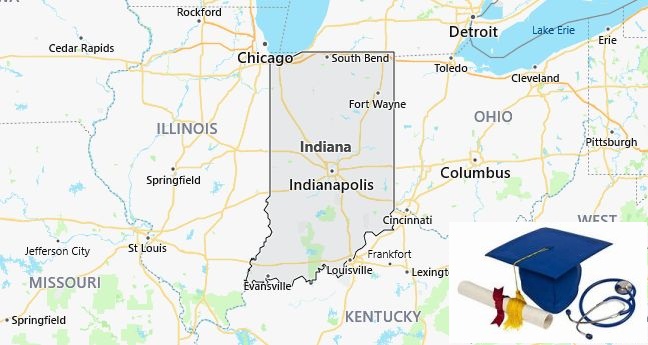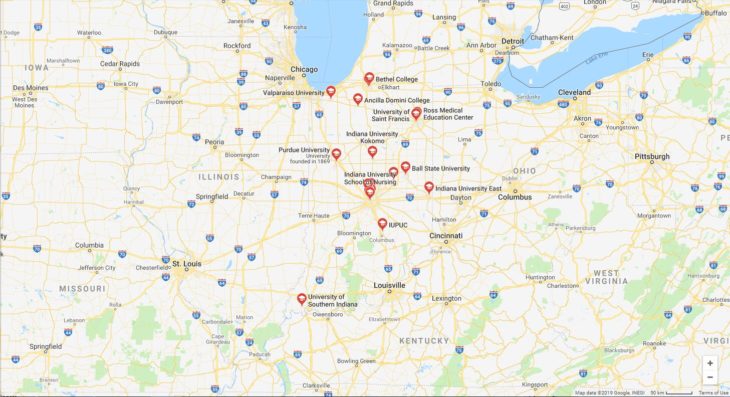If you intend to purse a nursing degree in Indiana, you should aim at the top nursing schools in Indiana. Let’s show below, which schools have a standard curriculum for nursing education and are recognized by the market.
See the latest nursing school ranking of the state and check the top nursing colleges among the institutions and the best evaluated courses in Indiana.
List of Best Nursing Colleges in Indiana
| Rankings | Nursing Universities | Nursing Colleges |
| 1 | Indiana University Purdue University Indianapolis Mailing Address: 1111 Middle Drive, Indianapolis, IN 46202-5107 Phone Number: (317) 274-2806 E-mail: nursing@iupui.edu Website Homepage: http://nursing.iupui.edu/ |
School of Nursing |
| 2 | Indiana State University Mailing Address: 749 Chestnut Street, Terre Haute, IN 47809-1937 Phone Number: (812) 237-2316 E-mail: nursing@indstate.edu Website Homepage: http://www.indstate.edu/nursing/ |
College of Nursing |
| 3 | Purdue University Calumet Mailing Address: 2200 169th Street, Hammond, IN 46323 Phone Number: (219) 989-2815 E-mail: walkerc@calumet.purdue.edu Website Homepage: http://webs.purduecal.edu/nursing/ |
School of Nursing |
| 4 | University of Indianapolis Mailing Address: 1400 E. Hanna Avenue, Indianapolis, IN 46227 Phone Number: (317) 788-2128 E-mail: tcrum@uindy.edu Website Homepage: http://nursing.uindy.edu/ |
School of Nursing |
| 5 | Valparaiso University Mailing Address: LeBien Hall 103, Valparaiso, IN 46383 Phone Number: (219) 464-5289 E-mail: Janet.Brown@valpo.edu Website Homepage: http://www.valpo.edu/nursing/programs/ |
College of Nursing |
| 6 | Ball State University Mailing Address: 2000 W. University Avenue, Muncie, IN 47306 Phone Number: (765) 285-5571 E-mail: nursing@bsu.edu Website Homepage: http://www.bsu.edu/nursing/ |
School of Nursing |
| 7 | Indiana Wesleyan University Mailing Address: 4201 S. Washington Street, Marion, IN 46953 Phone Number: (765) 677-2045 E-mail: steve.evans@indwes.edu Website Homepage: http://graduatenursing.indwes.edu/ |
Graduate Nursing Program |
| 8 | Anderson University Mailing Address: 1100 E. Fifth Street, Anderson, IN 46012 Phone Number: (800) 428-6414 E-mail: info@anderson.edu Website Homepage: http://www.anderson.edu/nursing |
School of Nursing |
| 9 | University of Southern Indiana Mailing Address: 8600 University Boulevard, Evansville, IN 47712-3596 Phone Number: (812)465-1197 Website Homepage: http://health.usi.edu/acadprog/nursing/msn/default.asp |
School of Nursing and Health Professions |
| 10 | University of St. Francis Mailing Address: 2701 Spring Street, Fort Wayne, IN 46808 Phone Number: (800) 729-4732 Website Homepage: http://www.sf.edu/healthscience/nursing/index.shtml |
Department of Nursing |

Indiana Early History
In 1787, the “Old Northwest” became a US territory, which included all the lands between the Appalachians in the east and the Mississippi in the west, the Great Lakes in the north, and the Ohio River in the south. Indiana was included in the new Northwest Territory. Then there were only two American settlements – Vincennes and Clarksville named after George Clark, and the European population of Indiana did not exceed five thousand people. In 1800, the Indiana Territory was separated from the Northwest Territory, which included the lands of the modern states of Indiana, Illinois and Wisconsin, as well as parts of Minnesota, Michigan and Ohio. Indiana gained its borders with the creation of the State of Ohio in 1803, the Territory of Michigan in 1805, and the Territory of Illinois in 1809. The city of Vincennes became the first capital of Indiana Territory, and the future ninth President of the United States, William Harrison, became the first governor.
William Garrison was a supporter of allowing slavery in Indiana Territory, believing that the use of slave labor would ensure the growth of the Indiana economy and attract new settlers. Despite the fact that he actively lobbied for his position, not all residents supported him, and it was the issue of legalizing slavery that served as one of the reasons for the separation of Illinois. When a bicameral Legislative Assembly was first established in Indiana in 1809, anti-slavery forces won a landslide victory.
At the beginning of the 19th century, the Indians of the “Old Northwest”, dissatisfied with the rapid expansion of the Europeans, created an alliance under the leadership of the leader of the Shoni people Tecumseh and his brother Tenskwatawa, known as the “Prophet”. In August 1810, Tecumseh arrived in Vincennes with a detachment of armed Indians and met with Indiana Governor William Harrison. He demanded the abolition of the treaties under which the Indians (in particular the Miami people) sold their lands to the Americans. Harrison, who was very respectful of Tecumseh and even considered him a political genius, did not agree with the Indian leader, motivating his refusal by the fact that each of the Indian peoples can regulate their own relations with the US government. Tecumseh threatened that if the Americans did not make concessions, he would seek help from the British.
A year later, Harrison and Tecumseh met again, but did not reach a compromise. Tecumseh went south, hoping to get the support of the “five civilized tribes” (Cherokee, Chickasaw, Choctaw, Creek, and Seminole peoples who lived in the southeastern United States and had by that time established good relations with European settlers). During the absence of Tecumseh, the conflict escalated and on November 7, 1811, a detachment of the US Army led by Garrison attacked the village of Prophetstown near the Tippecane River, where the “Prophet” Tenskwatawa lived. At the Battle of Tippecane, American soldiers won, the village was burned, and the Indian alliance was significantly weakened. Tecumseh, as promised, actively supported the British in the war that began soon and even received the rank of general of the British army. He continued to fight, protecting primarily the interests of the Indian peoples.

